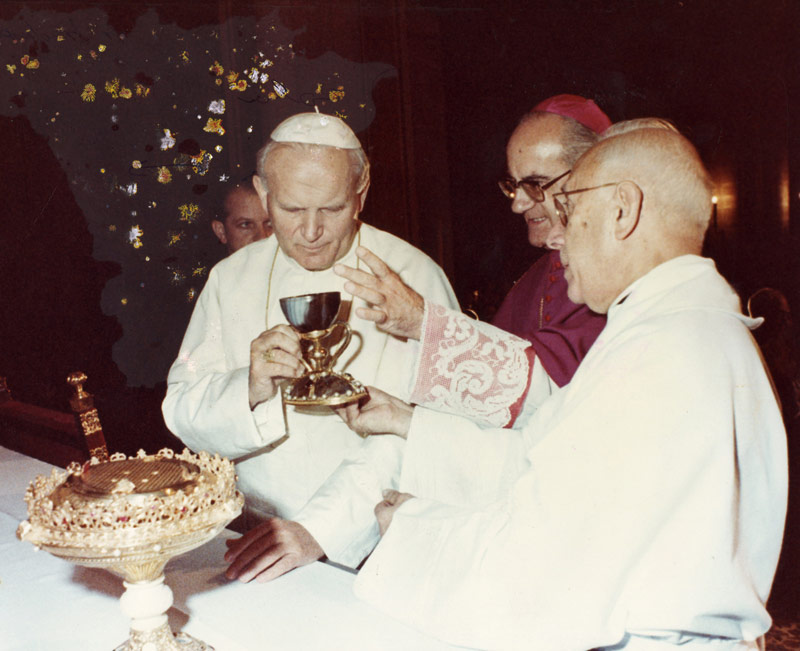The Grail is the legendary cup with which Jesus celebrated the Last Supper and in which was collected, by José de Arimathea, the blood that flowed from his side pierced by the spear of the Roman centurion Longinos during the crucifixion. There is much speculation about where the cup would be kept. It has been located in Argentine Patagonia, in a castle in France, in a basilica in Rome, in the basement of a convent in Portugal, in Glastonbury in England, in the Valencia Cathedral in Spain, to name a few hypotheses.
One of them, very suggestive, affirms that the Grail passed into the hands of two important Italian saints of the Catholic Church: Saint Francis of Assisi and Padre Pio.
from saint peter
This plot is revealed by some autograph documents, kept by Alberto Festa, nephew of Padre Pio’s doctor, Giorgio Festa, who examined his stigmata several times. Festa claims to have the Holy Grail in its custody, a bottle whose age, in an expert report commissioned by the owner himself, attests to its antiquity in the first century AD.
The Grail was initially guarded by Saint Peter, who supposedly kept it with him during his stay in Antioch (Turkey). Then the vicissitudes of the chalice in which the blood of Christ was collected are not clear. he would have stopped at the hands of the Templars and then transferred to Italy, in Venice, after the Fourth Crusade (1198), in which the Templars were almost exterminated.
San Francisco
Since then, the reconstructions about the Grail have been diverse. A hypothesis is the one that links it to San Francisco. During his pilgrimage, the saint of Assisi would have left him in the Sanctuary of the Madonna Incoronata, near Foggia, a city in southern Italy. The presence of the cup in that sanctuary would also be attested by another important saint: San Alfonso María de Ligorio, founder of the order of the Redemptorist Fathers.
In 1916, the cup would be delivered to Padre Pio. The Capuchin friar, in 1968, before his death, would in turn entrust it to a confrere, Father Cristoforo da Vico del Gargano.
Alberto Festa, imaginative film director and producer, holds in his hands a handwritten letter from Padre Pio which reads: “I entrust to Father Cristoforo da Vico del Gargano the remains of humble secrets that faithful Christians have given me. […]. I leave you the small Greek Vase of the Apostle Peter in my Secret because it is a Gift from God to my father and witness of the immense light. Save it for the poor of faith».
The “father” is Saint Francis, of whom Padre Pio was deeply devoted.
There is a graphological report on the letter, written by the expert Professor Alberto Bravo, dated 2003, according to which “comparative analysis confirms the traceability of the verified writing to the hand of Saint Padre Pio.”
a small vase
A thesis that has never completely convinced Father Florio Tessari, postulator of the cause for the canonization of Padre Pio. For Tessari, “there is no doubt about the authenticity of the objects, which have been appraised, but do not have any real, material meaning. They are a spirituality symbol».
“The vase dates back to the time of Jesus, and Peter may have touched it. It was probably taken from excavations in the Holy Land and brought as a gift to Padre Pio by Christian believers. But it is still a small vase that should not become a fetish.”
Even more skeptical was the vice postulator for the cause of beatification of Padre Pio, the late Father Gerardo Di Flumeri: according to him, in March 1968 Padre Pio no longer wrote anything, except his signatureand that handwriting looks too juvenile.
very questionable
Recently, the head of an association of devotees of Padre Pio consulted Alberto Festa’s documents and posted them on social networks, along with the supposed chalice, the Holy Grail. For the record, the chalice and the letter signed by Padre Pio were acquired by Festa in 2006, for a value of about 75,000 euros. Before him, they were in the possession of a certain Emanuele Cervone, who acted as an intermediary between the relatives of Father Cristóforo from Vico del Gargano, to whom Padre Pio would have given it as a gift in March 1968.
The writer Francesco Guarino, author of numerous books on Padre Pio and a student of the spirituality of the Capuchin friar, comments to El Debate: «I know the matter. I believe that the most authoritative position on the supposed Holy Grail and Padre Pio is the one expressed by the postulator and vice-postulator of the Cause for Canonization. There are many objects donated to Padre Pio during his lifetime, and museums have also been created throughout the world by the friar’s many devotees. Ascribing that small vase to the Grail with certainty seems highly questionable to me.. Padre Pio is rather a giant of Italian spirituality and history of the 20th century. Let’s leave him at that level.”
Is the holy grail in Florence? This is what Padre Pio believed


